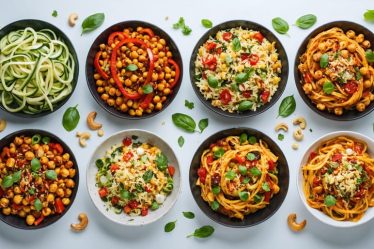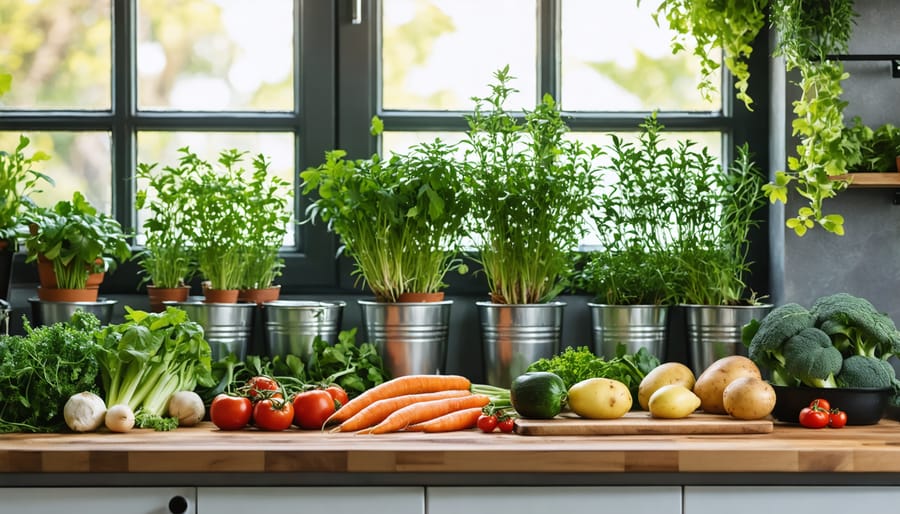
Transform your kitchen into an eco-conscious haven by embracing sustainable cooking practices that benefit both the planet and your wallet. Start by planning meals around seasonal, locally-sourced ingredients to reduce food miles and support regional farmers. Replace single-use plastics with reusable storage containers, cloth produce bags, and beeswax wraps to minimize kitchen waste. Organize your refrigerator strategically – keeping fruits and vegetables visible and properly stored – to prevent food spoilage and reduce the estimated 30-40% of food waste in American households.
Master the art of “root-to-stem” cooking by utilizing entire ingredients: turn carrot tops into pesto, roast potato peels for chips, and simmer vegetable scraps into flavorful broths. Choose energy-efficient cooking methods like batch cooking, using lids to retain heat, and matching pot sizes to burner dimensions. Install a small herb garden in your kitchen window to ensure fresh, package-free herbs while reducing grocery trips.
By incorporating these mindful practices into your daily cooking routine, you’ll join a growing community of home cooks who prove that sustainable cooking isn’t just environmentally responsible – it’s also creative, cost-effective, and deeply satisfying. Let’s explore how small changes in your kitchen can create a significant impact on our planet’s future.
The Magic of Seasonal Cooking
Understanding Your Local Growing Seasons
Did you know that understanding your local growing seasons is like having a secret recipe for smart seasonal sourcing? I learned this firsthand when I started my own kitchen garden, and it completely transformed how I approach cooking!
Start by connecting with local farmers’ markets or agricultural extension offices – they’re treasure troves of information about what grows when in your area. Download a seasonal produce calendar specific to your region, or better yet, create your own by noting when different fruits and vegetables appear at your local market.
Remember that growing seasons vary significantly by climate zone. While my friends in California enjoy fresh tomatoes well into fall, here in the Northeast, we’re already switching to root vegetables and hardy greens. Use online tools or apps that track seasonal produce in your area, and don’t be shy about chatting with local farmers – they love sharing their knowledge!
Consider joining a community garden or CSA (Community Supported Agriculture) program. These hands-on experiences provide invaluable insights into local growing patterns and connect you with fellow food enthusiasts who can share their seasonal cooking wisdom.
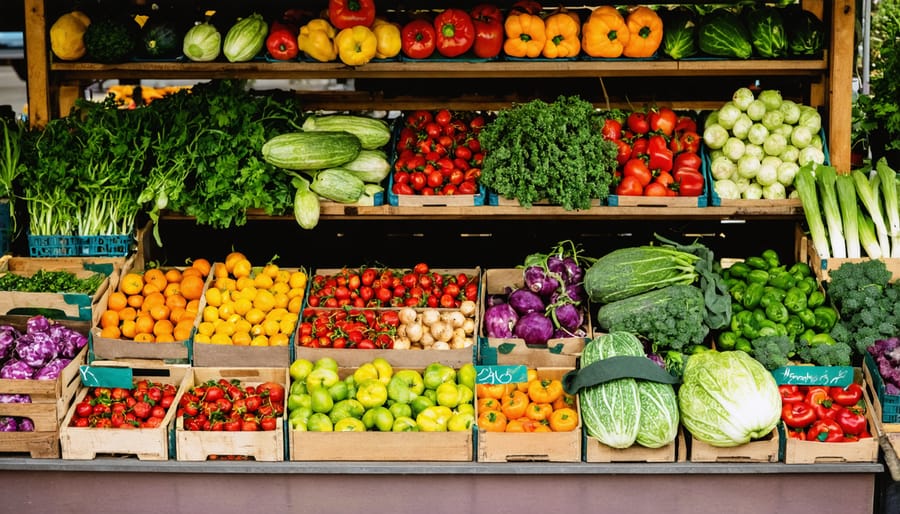
Building Relationships with Local Farmers
Building relationships with local farmers isn’t just about buying fresh produce – it’s about becoming part of your local food community. I remember feeling intimidated at my first farmers market visit, but now I chat with my favorite vendors like old friends! Start by becoming a regular at your local market and taking time to engage with farmers. Ask about their growing practices, what’s coming into season, and their favorite ways to prepare different ingredients.
Many farmers are happy to share cooking tips and might even offer you first pick of their best produce once they know you. Consider joining a CSA (Community Supported Agriculture) program, which provides regular boxes of seasonal produce while supporting local farms. Some farmers also welcome visitors for farm tours or harvest days – these experiences can be incredibly enriching and educational.
Don’t forget to follow your favorite vendors on social media to stay updated on market schedules and seasonal offerings. Building these connections not only ensures you get the freshest ingredients but also helps create a more sustainable local food system that benefits everyone.
Smart Shopping for Sustainable Ingredients
Reading Food Labels Like a Pro
Have you ever stood in the grocery store, staring at food labels and feeling a bit overwhelmed? Trust me, I’ve been there! But becoming a label-reading pro is easier than you might think, and it’s a crucial skill for sustainable cooking.
First, let’s talk about those eco-friendly certifications. When you see “USDA Organic,” you can trust that the product was grown without synthetic pesticides and follows strict environmental standards. The “Fair Trade” label ensures farmers received fair compensation for their work, while “Marine Stewardship Council (MSC)” indicates sustainably sourced seafood.
Look beyond the front of the package – that’s where marketing lives! The real story is on the back panel. Check the ingredient list: shorter is usually better, and ingredients are listed by quantity (highest to lowest). When possible, choose products with recognizable, whole-food ingredients.
Here’s a pro tip I learned from a local chef: Pay attention to packaging materials. Products in recyclable or biodegradable packaging are often made by companies that prioritize sustainability throughout their production process.
Country of origin labels can help you make decisions about food miles – the distance your food traveled to reach you. When choosing between similar products, opt for those produced closer to home to reduce transportation emissions.
Remember, you don’t need to be perfect! Start with small changes, like choosing one or two sustainable certifications to focus on, and build from there.
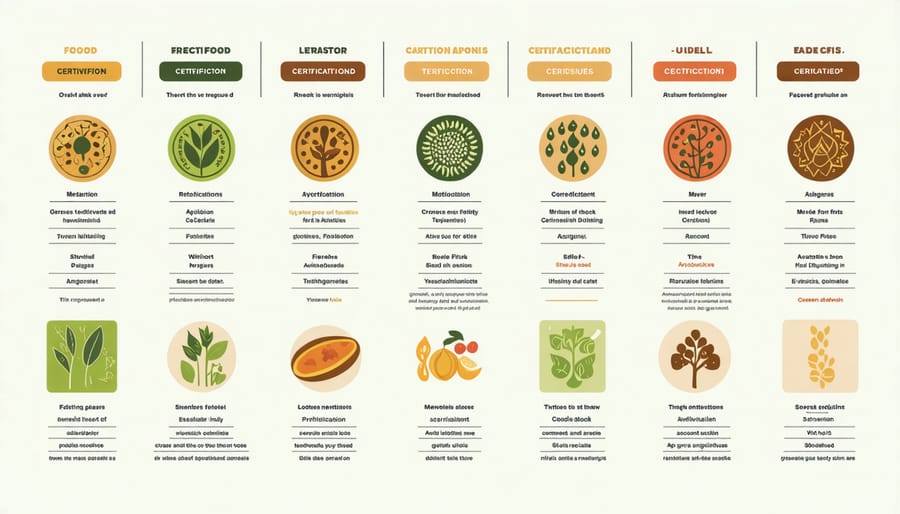
Budget-Friendly Sustainable Shopping
Being eco-conscious doesn’t have to break the bank! As someone who’s navigated the journey toward sustainable eating habits, I’ve discovered plenty of budget-friendly ways to shop mindfully.
Start by planning your meals ahead and creating detailed shopping lists. This simple step prevents impulse purchases and reduces food waste – a win for both your wallet and the planet. Consider joining local food-sharing apps or community groups where people exchange excess produce or share bulk purchases.
Shop seasonally at farmers’ markets, especially during the last hour when vendors often offer discounts. Don’t shy away from “ugly” produce – these perfectly edible but less aesthetically pleasing fruits and vegetables are usually cheaper and would otherwise go to waste. Many stores now have dedicated sections for these items.
Bulk buying stations are your best friends for pantry staples like grains, nuts, and legumes. Bring your own containers to eliminate packaging waste and save money. Look for package-free stores in your area, but if they’re not available, many conventional supermarkets now offer bulk options.
Join local co-ops or community-supported agriculture (CSA) programs – these often provide fresh, local produce at lower prices than retail stores. Remember, sustainable shopping isn’t about perfection; it’s about making mindful choices that work for your budget and lifestyle.
Kitchen Practices That Make a Difference
Zero-Waste Cooking Techniques
I love sharing how adopting zero-waste kitchen practices can be both creative and rewarding. Let’s start with the “root-to-stem” approach – something I discovered during my own sustainability journey. Instead of tossing carrot tops, turn them into a vibrant pesto. Those broccoli stems? Slice them thinly for a crunchy slaw!
Keep a “stock bag” in your freezer for vegetable scraps like onion skins, celery ends, and herb stems. When it’s full, simmer the contents for a flavorful homemade broth. Trust me, it’s a game-changer for soups and risottos!
Citrus peels can be candied or infused in vinegar for natural cleaning solutions. Stale bread transforms into breadcrumbs or croutons, while overripe fruits are perfect for smoothies or baking. I’ve found that planning weekly meals around what needs to be used first helps prevent forgotten produce from ending up in the bin.
Get creative with leftovers by reimagining them into new dishes. Yesterday’s roasted vegetables can become today’s frittata, while unused herbs can be dried or frozen in olive oil. Remember, imperfect produce is just as nutritious – those slightly bruised apples make wonderful applesauce!
The key is starting small and building these habits gradually. Soon enough, you’ll find yourself naturally thinking of creative ways to use every part of your ingredients.
Energy-Efficient Cooking Methods
You know what I love about smart cooking? It’s like a delicious dance between being kind to our planet and creating amazing meals. Let me share some game-changing techniques that’ll help you reduce your energy consumption while making your food taste even better.
Start by matching your pot size to your burner – it’s such a simple trick, but it makes a huge difference! When I switched to this method, I noticed my cooking times dropped significantly. And here’s a little secret: keeping lids on your pots while cooking can cut your energy use by up to 60%!
Batch cooking has become my weekend ritual. Not only does it save energy by cooking multiple meals at once, but it also gives me ready-to-eat meals throughout the week. I love using my slow cooker for this – it uses less energy than the oven and creates the most tender, flavorful dishes.
Speaking of ovens, try to resist peeking at your food while it’s baking. Each time you open the door, the temperature drops by 25°F, forcing your oven to work harder. Instead, use the oven light and timer as your guides. And whenever possible, opt for your microwave or toaster oven for smaller portions – they use significantly less energy than a full-sized oven.
Remember to defrost foods in your fridge overnight rather than using the microwave. This not only saves energy but also helps maintain better texture in your food. These small changes add up to make a big difference in both your energy bills and environmental impact!
Storage Solutions for Seasonal Bounty
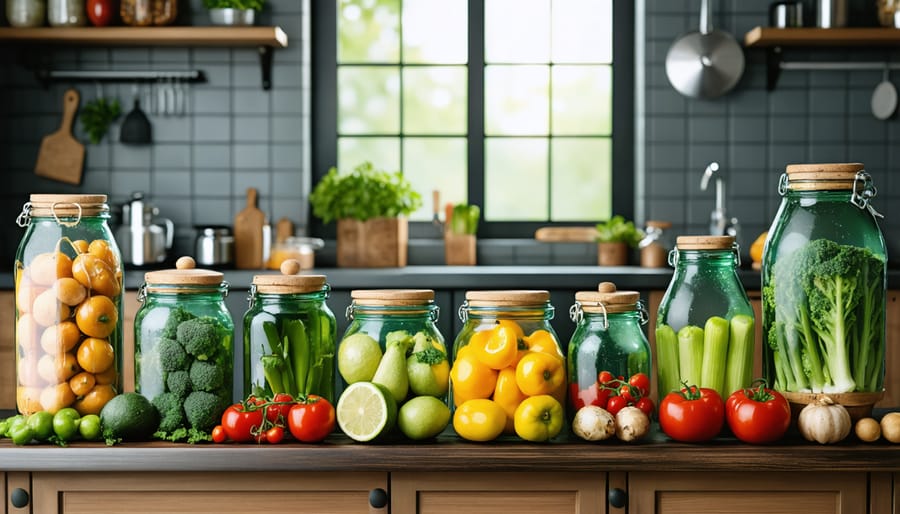
Preserving Methods for Different Ingredients
Let me share a game-changing discovery from my kitchen adventures: proper food preservation isn’t just about reducing waste – it’s about making the most of seasonal bounty all year round! The key is matching each ingredient with its perfect preservation method.
For leafy greens and herbs, blanching before freezing works wonders. Just dip them in boiling water briefly, plunge into an ice bath, and freeze flat in bags. Root vegetables like carrots and beets stay crisp for months when stored in sand or sawdust in a cool, dark place. Remember those gorgeous summer tomatoes? They’re perfect for canning or drying.
Fermentation is another fantastic option – think homemade sauerkraut or kimchi. Not only does it preserve your veggies, but it also creates delicious probiotic-rich foods. For fruits, try making jams with less sugar using pectin, or experiment with dehydrating for healthy snacks.
My personal favorite is quick pickling – just combine vinegar, water, salt, and your favorite spices. It works beautifully for cucumbers, radishes, and even cauliflower, keeping them crisp and flavorful for weeks in the fridge.
Smart Storage Tips
Let me share a game-changing discovery from my kitchen journey: proper storage isn’t just about keeping food fresh – it’s a key ingredient in sustainable cooking! I’ve learned that storing ingredients correctly can significantly reduce food waste and help us save money while protecting the environment.
For fresh produce, remember the “ethylene rule.” Some fruits like apples and bananas release ethylene gas, which can speed up ripening in other produce. Store these separately from ethylene-sensitive items like leafy greens and carrots. Keep most vegetables in the crisper drawer, but store potatoes, onions, and garlic in a cool, dark place – never in the fridge.
For pantry items, transfer grains, pasta, and dried goods into airtight glass containers. This not only keeps them fresher longer but also helps you easily spot what you have, preventing unnecessary purchases. Label everything with purchase dates, and follow the “first in, first out” principle.
When it comes to leftovers, clear glass containers are your best friends. They make it easy to see what’s inside, reducing the chance of forgotten food turning into waste. Pro tip: keep a “eat me first” section in your fridge for items nearing their use-by date.
Starting your sustainable cooking journey might feel overwhelming at first, but remember that every small step counts. As we’ve explored throughout this article, sustainable cooking isn’t just about following a set of rules – it’s about making mindful choices that work for you and your lifestyle while contributing to a healthier planet.
I’ve found that the most successful approach is to start with one or two changes that feel manageable. Maybe you’ll begin by planning your meals to reduce food waste, or perhaps you’ll commit to shopping at your local farmers’ market twice a month. Whatever you choose, celebrate these initial steps and build from there.
Remember, sustainable cooking is as much about community as it is about individual choices. Share your experiences with friends and family, swap recipes, and learn from others who are on the same journey. In my own experience, some of my best sustainable cooking discoveries came from conversations with fellow food enthusiasts at community gardens and local markets.
The beauty of sustainable cooking lies in its ripple effect – when we make conscious choices in our kitchens, we inspire others to do the same. Whether you’re reducing food waste, choosing seasonal ingredients, or supporting local producers, each decision makes a difference.
So, are you ready to transform your kitchen into a more sustainable space? Start today with whatever feels right for you, and watch how these small changes add up to make a meaningful impact on both your life and our planet.

